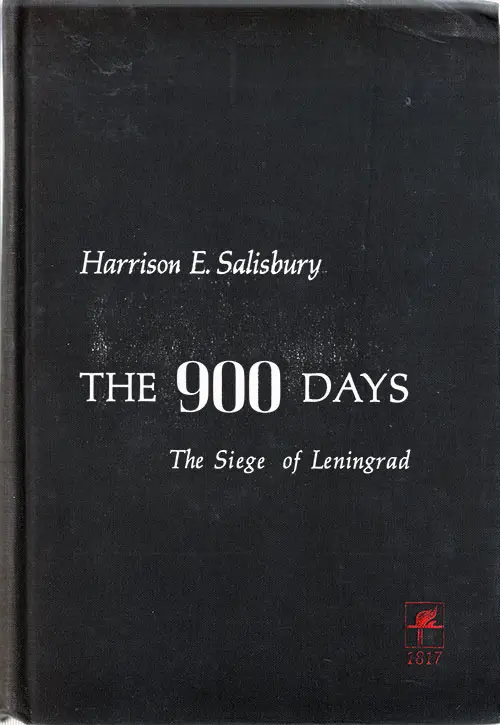The 900 Days: The Siege of Leningrad

Front Cover, The 900 Days: The Siege of Leningrad by Harrison E. Salisbury, 1969. GGA Image ID # 17ee072803
The Third Reich siege of Leningrad from 1941 to 1944 was one of the most gruesome episodes of World War II. Nearly three million people endured it; just under half of them died. For twenty-five years the distinguished journalist and historian Harrison Salisbury pieced together this remarkable narrative of villainy and survival, in which the city had much to fear-from both Hitler and Stalin.
From the inside Dustjacket flap:
"Let no one forget. Let nothing be forgotten." These lines from a poem by a Leningrad poetess are incised in the wall of the cemetery where nearly one million victims of the siege of Leningrad lie.
In Scale, the tragedy of Leningrad dwarfs even the Warsaw ghetto or Hiroshima. The siege was the longest a great city has undergone since Biblical times. It was endured by more than three million people, of whom just under one-half died...most of them in six months--from late October, 1941, through mid-April, 1942--when the temperature went from 20 to 30 degrees below zero, and there was no heat, no light, no transport, no food or water; the front was still active; bombs and shells rained down; and the cannibals--some say--became kings.
For twenty-five years Harrison Salisbury has been assembling the material out of which her forged this epic story. He went to Leningrad in January, 1944, after the siege was lifted, and talked to the survivors. He has examined Russian archives and secret records made available: it would not have been possible to piece together this puzzle during Stalin's lifetime.
The narrative begins--like a Greek tragedy--with the factors that were to determine Leningrad's fate: Stalin's paranoid fear and hatred of the city...the most Europeanized in Russia; his inability to believe Hitler would attack; the crucial errors of Leningrad's political leaders vis-a-vis the Kremlin.
Given those elements, what followed was inevitable. Salisbury exposes for the first time the role of Stalin's political police throughout the war and the endless blunders of the military. But he celebrates with ardor the magnificent citizens of Leningrad--artists, writers, factory workers, mothers, old men, children--who struggled, starved and died in the streets, but did not yield.
The culminating disaster, with which the story concludes, was the "Leningrad Affair" three years after the war ended. In that infamous plot, contrived by Stalin, almost every official who had been instrumental in the city's survival was implicated. All were convicted and executed. What Hitler's armies left unfinished; Stalin achieved.
The epic of the 900 days is known only in part inside Russia, and scarcely at all in the outside world. Harrison Salisbury has now told it for all time, in a narrative whose range and power are commensurate with the subject.
There are 16 full pages of black and white photos. Of the people of Leningrad during the siege, some who died and some who survived. Inside end pages are of a map of Western U.S.S.R & Eastern Europe at the time. The maps and pictures are all in perfect condition, too.
The author, Harrison E. Salisbury, is the author of two other books about Russia. A New Russia (1962) and a novel, The Northern Palmyra Affair (1962), about the city and citizens of Leningrad, for which he had a deep and special affection. He was born in Minneapolis, MN in 1908. At the time this novel was published he was Assistant Managing Editor of The New York Times.
Library of Congress Catalog Listing
- LC Control No.: 68028215
- Type of Material: Book (Print, Microform, Electronic, etc.)
- Personal Name: Salisbury, Harrison E. (Harrison Evans), 1908-1993.
- Main Title: The 900 days; the siege of Leningrad [by] Harrison E. Salisbury.
- Edition Information: [1st ed.]
- Published/Created: New York, Harper & Row [1969]
- Description: xi, 635 p. illus., maps (1 col.) 25 cm.
- Notes: Bibliography: p. 597-610.
- Subjects: Saint Petersburg (Russia) --History --Siege, 1941-1944.
- LC Classification: D764.3.L4 S2
- Dewey Class No.: 940.542/1
- Geographic Area Code: e-ur-ru
